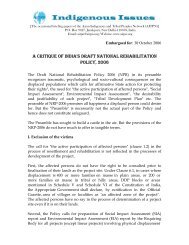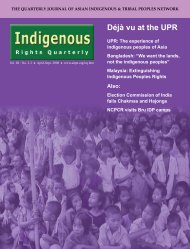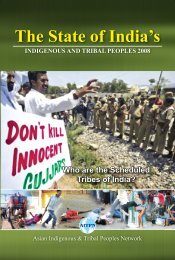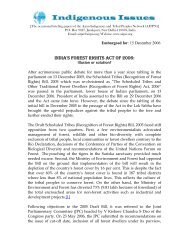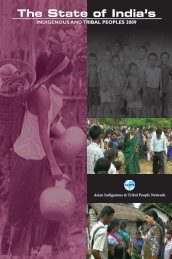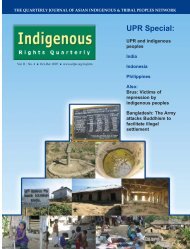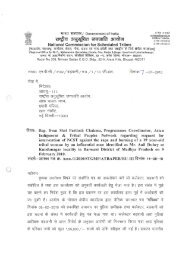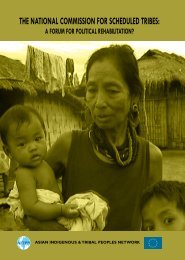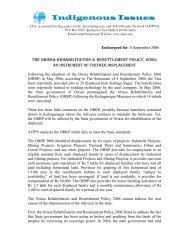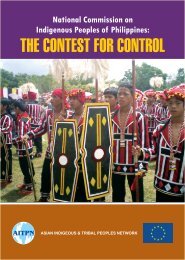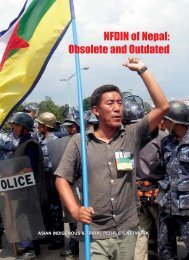India: - Asian Indigenous and Tribal Peoples Network
India: - Asian Indigenous and Tribal Peoples Network
India: - Asian Indigenous and Tribal Peoples Network
Create successful ePaper yourself
Turn your PDF publications into a flip-book with our unique Google optimized e-Paper software.
P.O.Box 9627, JanakpuriNew Delhi-110058, <strong>India</strong>Tel: + 91-11-25503624Fax:+ 91-11-25620583E-Mail: aitpn@aitpn.orgWebsite: www.aitpn.orgClassensgade 11 E, DK 2100Copenhagen, DenmarkPhone: (+45) 3570500Fax: (+45) 35 27 05 07E-mail: iwgia@iwgia.orgWebsite: www.iwgia.orgEmbargoed for: 20 November 2007<strong>India</strong>:No democracy for those living on the margins[Contribution under the Universal Periodic Review of the Human Rights Council]Table of contents1. EXECUTIVE SUMMARY ............................................................................................ 3I. SITUATION OF INDIGENOUS AND TRIBAL PEOPLES ON THE GROUND............................... 3II. ASSESSMENT OF INDIA'S HUMAN RIGHTS OBLIGATIONS AND COMMITMENTS ............... 5III. ENHANCEMENT OF STATE’S CAPACITY/TECHNICAL COOPERATION............................. 7IV. COOPERATION WITH HRC, TREATY BODIES AND OHCHR ........................................ 82. SITUATION OF INDIGENOUS AND TRIBAL PEOPLES ON THE GROUND....... 9I. LAND ALIENATION......................................................................................................... 9II. DEVELOPMENT AND VICTIMIZATION OF THE TRIBALS .................................................. 9III. FAILURE TO IMPLEMENT FOREST RIGHTS ACT, 2006................................................ 12IV. ARMED CONFLICT, HUMAN RIGHTS VIOLATIONS AND DISCRIMINATION AGAINSTINDIGENOUS IDPS........................................................................................................... 13V. STATUS OF PARTICULARLY VULNERABLE TRIBAL GROUPS ........................................ 15VI. STATUS OF THE SOCALLED CRIMINAL TRIBES .......................................................... 163. ASSESSMENT OF INDIA'S HUMAN RIGHTS OBLIGATIONS ANDCOMMITMENTS............................................................................................................. 18I. FAILURE TO IMPLEMENT AFFIRMATIVE ACTION PROGRAMMES .................................... 18a. Non-implementation of the reservations in employment........................................ 18b. <strong>Tribal</strong> Sub Plan <strong>and</strong> misuse of funds...................................................................... 20II. FAILURE OF THE NATIONAL MECHANISMS .................................................................. 21a. The National Commission for the Scheduled Tribes.............................................. 21b. Lack of implementation of the Scheduled Castes <strong>and</strong> Scheduled Tribes (Preventionof Atrocities) Act, 1989............................................................................................... 22
<strong>India</strong>:No democracy for those living on the margins2III. NON-IMPLEMENTATION OF SUPREME COURT JUDGMENTS........................................ 23a. Citizenship rights to the Chakmas <strong>and</strong> Hajongs .................................................... 23b. Endangered tribes: The Jarawas ........................................................................... 244. ENHANCEMENT OF STATE’S CAPACITY/TECHNICAL COOPERATION....... 245. COOPERATION WITH HRC, TREATY BODIES AND OHCHR............................ 24______________________________________________________________________________[A joint submission of IWGIA <strong>and</strong> AITPN for examination of <strong>India</strong>’s human rightsobligations <strong>and</strong> commitments under the UPR of the Human Rights Council]
<strong>India</strong>:No democracy for those living on the margins31. Executive summaryI. Situation of indigenous <strong>and</strong> tribal peoples on the groundHuman rights situation of the indigenous <strong>and</strong> tribal peoples in <strong>India</strong> remain grim, itsfuture bleak. Since independence indigenous peoples were rightly seen as victims ofdevelopment <strong>and</strong> encroachments by non-tribals. The pauperisation of the tribalscontinued unabated <strong>and</strong> unchecked. The affirmative action programmes could not simplykeep the pace with the marginalization of the indigenous <strong>and</strong> tribal peoples.Presently, the situation of the tribals fits into a classical left wing extremism. Accordingto the figures of the Ministry of Home Affairs 21 out of 28 States are afflicted by armedconflict <strong>and</strong> majority of these States are afflicted by the Naxalite conflicts, the extremeleft wing armed opposition groups. The Naxals (Maoists) are active mainly in the tribalbelts in mainl<strong>and</strong> <strong>India</strong>. Neither the Naxal movement is led by the tribals, nor do thedem<strong>and</strong>s of the Naxalites relate to the tribals. The tribal simply fit into their class-war ofthe Naxalites. They are victims as well as perpetrators, <strong>and</strong> the pawns of the conflict.The government continues with its knee-jerk reactions. The Forest Rights Act, 2006 wasadopted in December 2006 but it is yet to be implemented. The Relief <strong>and</strong> RehabilitationPolicy has been revised twice since 2003, the latest one was made public in November2007. A National <strong>Tribal</strong> Policy has been in the pipeline since 2004. Now, the governmenthas proposed to set up a L<strong>and</strong> Commission.All the measures are up in the air. As the conflict intensifies, the tribals will get furtherbrutalized.a. L<strong>and</strong> alienationThe constitutional safeguards as provided in the 5 th Schedule <strong>and</strong> 6 th Schedule to theConstitution of <strong>India</strong> <strong>and</strong> various other State level laws which among others prohibittransfer of the l<strong>and</strong>s of the tribal people have failed to prevent widespread l<strong>and</strong> alienationof the tribals. The root cause of the l<strong>and</strong> alienation has been the L<strong>and</strong> Acquisition Act of1894 under which the government can exercise its sovereign power to take away any l<strong>and</strong>in the name of “public purposes”.The non-tribals have also illegally occupied hundreds of thous<strong>and</strong>s of acres of l<strong>and</strong>belonging to tribals by force, allurement <strong>and</strong> acquiring tribal l<strong>and</strong>s in the name of tribalwives after marrying them. According to the 2004-2005 Annual Report of Ministry ofRural Development of the government of <strong>India</strong>, 3,75,164 cases of tribal l<strong>and</strong> alienationhave been registered covering 85,52,82 acres of l<strong>and</strong> in 10 States. Out of these, only1,62,650 cases had been disposed in favour of tribals covering a total area of 4,47,314______________________________________________________________________________[A joint submission of IWGIA <strong>and</strong> AITPN for examination of <strong>India</strong>’s human rightsobligations <strong>and</strong> commitments under the UPR of the Human Rights Council]
<strong>India</strong>:No democracy for those living on the margins4acres while 1,54,993 cases covering an area of 3,63,493 acres of l<strong>and</strong> had been decidedagainst the tribals by the Courts on various grounds. 1b. Development <strong>and</strong> victimization of the tribals<strong>Indigenous</strong>/tribal peoples who constituted 8% of the total population of <strong>India</strong> as per 1991census also constituted 55.1% of the total development project-induced displaced personsup to 1990 on account of mega developmental projects like dams, mining, industries <strong>and</strong>conservation of nature etc. 2 And they were seldom rehabilitated. As <strong>India</strong>’s boomingeconomy requires more resources, indigenous/tribal peoples face more displacement.In the last three years, the National Policy on Resettlement <strong>and</strong> Rehabilitation for ProjectAffected Families of 2004 has to be amended twice – in 2006 <strong>and</strong> 2007. But the NationalPolicy on Resettlement <strong>and</strong> Rehabilitation of 2007 also failed to address the problemsarising out of the State exercising its sovereign power to forcibly acquire l<strong>and</strong>s ofanybody under the L<strong>and</strong> Acquisition Act of 1894.c. Failure to ensure forest rightsThe National Forest Policy of 1988 recognises symbiotic relationship between forest <strong>and</strong>tribal people. Yet, the tribals have been systematically victimized under the Forest Act of1927. When the Forest Conservation Act of 1980 came into force, hundreds of thous<strong>and</strong>sof tribal people became encroachers overnight on the l<strong>and</strong>s they had been living forgenerations. On 23 November 2001, the Supreme Court altogether stayed theregularisation of tribal villages in forest areas in the case of Godavarman Thirumalpad vsUnion of <strong>India</strong> in Interlocutory Application No.703 in Writ Petition No. 202/95.In 2006, the government of <strong>India</strong> brought the Scheduled Tribes <strong>and</strong> Other TraditionalForest Dwellers (Recognition of Forest Rights) Act. The government of <strong>India</strong> till todayhas failed to notify the Rules of Procedures of the Forest Rights Act of 2006. In themeanwhile, tribals continue to be prosecuted for accessing minor forest produce. Therewere 2,57,226 forest cases pending against 1,62,692 tribals between 1953 <strong>and</strong> 30 June2004 under different Sections of the Forest Act of 1927 in Chhattisgarh as on 8November 2005, 3 <strong>and</strong> 2,531 such cases were pending against tribals in Orissa as on 10March 2005. 4d. Conflicts, human rights violations <strong>and</strong> discrimination against indigenous IDPsPresently, 21 out of 28 States of <strong>India</strong> are afflicted by internal armed conflicts. All theareas afflicted by internal armed conflicts, except Jammu <strong>and</strong> Kashmir are pre-1. Available at: http://rural.nic.in/annualrep0405/anualreport0405.htm2. Right over forest l<strong>and</strong> for tribals in the offing, The <strong>India</strong>n Express, 6 February 20063. Over two lakh forest cases against Chhattisgarh tribals to be withdrawn, The Hitavada, 11 November 20054. Naxalite bodies dem<strong>and</strong> probe into police firing, The Statesman, 14 March 2005______________________________________________________________________________[A joint submission of IWGIA <strong>and</strong> AITPN for examination of <strong>India</strong>’s human rightsobligations <strong>and</strong> commitments under the UPR of the Human Rights Council]
<strong>India</strong>:No democracy for those living on the margins5dominantly inhabited by indigenous <strong>and</strong> tribal peoples. They suffer serious human rightsviolations from both the security forces <strong>and</strong> the armed opposition groups <strong>and</strong> impunityunder sections 6 of the Armed Forces Special Powers Act of 1958 <strong>and</strong> 197 of theCriminal Procedure Code has further perpetuated the human rights violations.<strong>Indigenous</strong>/tribal peoples also constitute over 40.6% (1,86,225) of 4,58,225 conflictinducedinternally displaced persons (IDPs) in <strong>India</strong>. 5 They face discrimination in termsof basic services provided by the State. While a displaced Kashmiri P<strong>and</strong>it received Rs750 per month, an adult Bru indigenous person received only Rs. 2.67 paise a day i.e. Rs80 per month. 6e. Status of Particularly Vulnerable <strong>Tribal</strong> Groups (PVTGs)Many of the PVTGs have been on the verge of extinction. As per statistics of 1991, therewere only 24 Sentinelese, 32 Great Andamense, 89 Jarawa, 101 Onge <strong>and</strong> 131 Shom Pen.There were only 23 families comprising about 100 members of Karbong tribe reportedlysurviving in Tripura 7 but the government of <strong>India</strong> has not recognized the Karbong tribe as“Particularly Vulnerable <strong>Tribal</strong> Group”. There are specific programmes meant for thedevelopment of the PVTGs but their implementation has been poor <strong>and</strong> the governmenthas failed to establish independent monitoring mechanism.f. Status of the Socalled Denotified <strong>Tribal</strong> GroupsThe British identified some tribal groups as “criminal tribes under the Criminal TribesAct of 1871. The government of <strong>India</strong> identifies them as “habitual offenders” under theHabitual Offenders Act of 1952. The stigma continues including in the administration ofjustice. The government has established a National Commission on the Denotified Tribesbut it does not have the same power <strong>and</strong> functions like the National Commission forScheduled Tribes.II. Assessment of <strong>India</strong>'s human rights obligations <strong>and</strong> commitmentsThe government of <strong>India</strong> has failed to implement its obligations <strong>and</strong> commitment asprovided under the Constitution <strong>and</strong> international human rights law.Affirmative Actionsa. Non-implementation of the reservations in employmentThe government failed to implement 7.5% job reservations in government sectors for theScheduled Tribes (both in terms of recruitment <strong>and</strong> promotion) as provided under the5. The State of <strong>India</strong>’s <strong>Indigenous</strong> <strong>and</strong> <strong>Tribal</strong> <strong>Peoples</strong> 2007, <strong>Asian</strong> <strong>Indigenous</strong> <strong>and</strong> <strong>Tribal</strong> <strong>Peoples</strong> <strong>Network</strong>6. <strong>India</strong> Human Rights Report 2006, <strong>Asian</strong> Centre for Human Rights7. Only 23 families still surviving, The Sentinel, 25 June 2005______________________________________________________________________________[A joint submission of IWGIA <strong>and</strong> AITPN for examination of <strong>India</strong>’s human rightsobligations <strong>and</strong> commitments under the UPR of the Human Rights Council]
<strong>India</strong>:No democracy for those living on the margins6Constitution of <strong>India</strong>. There were thous<strong>and</strong>s of backlog vacancies for the ScheduledTribes across the country. For example, according to figures available with the Ministryof Social Justice & Empowerment in September 2006, the share of Scheduled Tribes inthe government services such as Group ‘A’ was 4.1 per cent, Group ‘B’ at 4.6 per cent,Group ‘C’ at 6.7 per cent <strong>and</strong> Group ‘D’ at 6.7 per cent against the reserved quota of 7.5per cent in each group. 8b. Failure to implement <strong>Tribal</strong> Sub PlanUnder Article 271, the government of <strong>India</strong> is required to launch various schemes for thedevelopment of the tribals. But these schemes <strong>and</strong> programmes have remained largelypoorly implemented. Funds allocated for the Scheduled Tribes have been either divertedor not utilized. Since the Fiscal Responsibility <strong>and</strong> Budget Management Act came intoforce in July 2004, which requires submission of utilization reports by the Stategovernments, a total of Rs 1,522.90 crores (Rs 15,229 millions) could not be released bythe Ministry of <strong>Tribal</strong> Affairs to various state governments as of December 2005 becausethese state governments did not submit utilization reports for the funds earlier disbursedto them. 9 The government of <strong>India</strong> has failed to develop independent monitoringmechanism for proper utilization of the funds meant for the tribal people.National mechanisms:a. National Commission for the Scheduled TribesIn 2004, the National Commission for Scheduled Tribes (NCST) was established toaddress violations <strong>and</strong> ensure the rights of the tribals. But it has miserably failed to liveup to its m<strong>and</strong>ate because of inherent flaws including in appointment procedures, lack ofpowers to enforce its rulings or recommendation, <strong>and</strong> lack of resources. Mostsurprisingly, the NCST has also adopted such rules of procedures which made theCommission subservient to the State authorities. The NCST’s head office has 12 officersto look after the rights of 84 million indigenous/tribal peoples.In fact, none of the Annual Reports of the National Commission for the Scheduled Tribeshave so far been made public.b. Scheduled Castes <strong>and</strong> Scheduled Tribes (Prevention of Atrocities) Act, 1989The Scheduled Castes <strong>and</strong> Scheduled Tribes (Prevention of Atrocities) Act of 1989 hasnot been implemented properly. In 2005, the overall conviction rate for the crimes againstthe Scheduled Tribes was only 24.2%. Conviction rates under SC/ST (Prevention ofAtrocities) Act) <strong>and</strong> Protection of Civil Rights Act were only 20.4% <strong>and</strong> 25%8. Quota as affirmative tool has failed: Report, The Pioneer, 4 September 20069. 17th Report of the St<strong>and</strong>ing Committee on Social Justice <strong>and</strong> Empowerment (2005-2006) May, 2006______________________________________________________________________________[A joint submission of IWGIA <strong>and</strong> AITPN for examination of <strong>India</strong>’s human rightsobligations <strong>and</strong> commitments under the UPR of the Human Rights Council]
<strong>India</strong>:No democracy for those living on the margins7respectively. 10 Many States governments have also failed to set up special courts to trythe offences against the Scheduled Castes <strong>and</strong> Scheduled Tribes as provided under theScheduled Castes <strong>and</strong> Scheduled Tribes (Prevention of Atrocities) Act, 1989.Lack of respect for the Supreme Court:The government of <strong>India</strong> shows scant regard for the Supreme Court <strong>and</strong> a number ofjudgements have not been implemented.a. Citizenship rights to the Chakmas <strong>and</strong> HajongsOn 9 January 1996, the Supreme Court in its judgement in the case of NHRC Vs State ofArunachal Pradesh [WP 9C) No. 720 of 1995], among others, directed the government of<strong>India</strong> to process the citizenship applications of the Chakmas <strong>and</strong> Hajongs. More than adecade has passed, the government of <strong>India</strong> failed to process a single citizenshipapplication. A fresh writ petition [W.P[C] No. 510 of 2007] for implementation of the1996 judgement is being considered by the Supreme Court again!b. Failure to shut down Andaman Trunk RoadIn 2002, the Supreme Court directed the government to close down the Andaman TrunkRoad that runs along <strong>and</strong> through the Jarawa <strong>Tribal</strong> Reserve in Andaman <strong>and</strong> NicoberIsl<strong>and</strong> <strong>and</strong> threatens the survival of the Jarawas, whose population as per 1991 statisticswas only 89 persons. But the government failed to shut down the Andaman Trunk Roaduntil today.If the government does not implement Supreme Court judgements, it is unlikely toimplement the recommendations of the Committees established by it. Therefore, therecommendations of the Justice B P Jeevan Reddy Committee on the Review of theArmed Forces Special Powers Act of 1958 (2006) <strong>and</strong> Administrative ReformsCommission (2007) on the repeal of the AFSPA remain unimplemented.III. Enhancement of State’s capacity/technical cooperationThe Human Rights Council should recommend technical cooperation programmes for theNational Commission for Scheduled Tribes, National Commission for Scheduled Castes,National Commission for Women, National Commission for Protection of Child Rights,National Commission for Minorities, National Commission for Denotified Tribes etc.There should be technical cooperation programmes for collection of disaggregated data.10. 2005 Annual Report of National Crime Records Bureau, Government of <strong>India</strong>______________________________________________________________________________[A joint submission of IWGIA <strong>and</strong> AITPN for examination of <strong>India</strong>’s human rightsobligations <strong>and</strong> commitments under the UPR of the Human Rights Council]
<strong>India</strong>:No democracy for those living on the margins8There should be a technical cooperation programmes for implementation of the ILOConvention No. 107 relating to indigenous <strong>and</strong> tribal peoples including increasingsensitivity of the judiciary on the rights of indigenous <strong>and</strong> tribal peoples.IV. Cooperation with HRC, Treaty Bodies <strong>and</strong> OHCHRThe government failed to ratify Convention against Torture <strong>and</strong> Other Cruel, Inhuman orDegrading Treatment or Punishment, International Convention for the Protection of AllPersons from Enforced Disappearance, <strong>and</strong> the ILO Convention No 169 on <strong>Indigenous</strong><strong>and</strong> <strong>Tribal</strong> <strong>Peoples</strong> in Independent Countries.The government of <strong>India</strong> has so far failed to extend open invitation <strong>and</strong> specificinvitations to many Special Procedures including Special Rapporteur on the situation ofhuman rights <strong>and</strong> fundamental freedoms on indigenous peoples.The periodic report to the Human Rights Committee has been pending since December2001. The government has also failed to implement the recommendations of the TreatyBodies.______________________________________________________________________________[A joint submission of IWGIA <strong>and</strong> AITPN for examination of <strong>India</strong>’s human rightsobligations <strong>and</strong> commitments under the UPR of the Human Rights Council]
<strong>India</strong>:No democracy for those living on the margins92. Situation of indigenous <strong>and</strong> tribal peoples on the groundI. L<strong>and</strong> alienationThe 5 th Schedule to the Constitution of <strong>India</strong> protects the l<strong>and</strong> rights of the tribals inmainl<strong>and</strong> <strong>India</strong> <strong>and</strong> the 6 th Schedule authorizes some of the Autonomous DistrictCouncils in the North East <strong>India</strong> to make appropriate laws against l<strong>and</strong> alienation subjectto approval by the Governor of the concerned State. In addition, there are State level lawsto protect the l<strong>and</strong> rights of the tribal <strong>and</strong> indigenous peoples.The non-tribals have also illegally occupied hundreds of thous<strong>and</strong>s of acres of l<strong>and</strong>belonging to tribals by force, allurement <strong>and</strong> acquiring tribal l<strong>and</strong>s in the name of tribalwives after marrying them. The State government of Andhra Pradesh informed the StateAssembly in March 2006 that non-tribal individuals have adopted dubious methods toillegally occupy tribal l<strong>and</strong>s in the names of tribal women after marrying them. As manyas 57,367 acres of l<strong>and</strong> earmarked for the tribals in the Scheduled Areas was under illegaloccupation of non-tribal individuals in West Godavari district. 11 According to the 2004-2005 Annual Report of Ministry of Rural Development of the government of <strong>India</strong>,3,75,164 cases of tribal l<strong>and</strong> alienation have been registered covering 85,52,82 acres ofl<strong>and</strong> in 10 States of Andhra Pradesh, Assam, Bihar (undivided), Gujarat, Karnataka,Madhya Pradesh (undivided), Maharashtra, Orissa, Rajasthan, <strong>and</strong> Tripura as of March2004. Out of these, 1,62,650 cases had been disposed in favour of tribals covering a totalarea of 4,47,314 acres while 1,54,993 cases covering an area of 3,63,493 acres of l<strong>and</strong>had been rejected by the Courts on various grounds. 12The government of <strong>India</strong> has recently announced to establish a L<strong>and</strong> Commission but itsdetails have not been released as yet. There is skepticism because of the past experiences.II. Development <strong>and</strong> victimization of the tribalsIn one h<strong>and</strong>, l<strong>and</strong> rights are provided under the 5 th <strong>and</strong> 6 th Schedules of the Constitutionof <strong>India</strong>. On the other, is the L<strong>and</strong> Acquisition Act of 1894 which prevails on the ground.Under the L<strong>and</strong> Acquisition Act, the government can take away any l<strong>and</strong> in the name of“public purposes”. In <strong>India</strong>, “public purposes” no longer refer to government taking awayl<strong>and</strong>s for the construction of roads, railway lines or government offices etc but has cometo mean the government exercising its sovereign power to take away l<strong>and</strong> of the poor <strong>and</strong>the disadvantaged sections of society for the benefit of the private companies.The tribal <strong>and</strong> indigenous peoples have been the disproportionate victims of displacementdue to socalled development projects such as setting up of industrial projects,construction of dams, mining, etc. <strong>Indigenous</strong>/tribal peoples who constituted 8% of thetotal population of <strong>India</strong> at 1991 census also constituted 55.1% of the total development11. <strong>Tribal</strong> l<strong>and</strong> occupied, The Deccan Chronicle, 22 March 200612. Available at: http://rural.nic.in/annualrep0405/anualreport0405.htm______________________________________________________________________________[A joint submission of IWGIA <strong>and</strong> AITPN for examination of <strong>India</strong>’s human rightsobligations <strong>and</strong> commitments under the UPR of the Human Rights Council]
<strong>India</strong>:No democracy for those living on the margins10project-induced displaced persons up to 1990. The Ministry of <strong>Tribal</strong> Affairs in its DraftNational Policy on the <strong>Tribal</strong>s stated that nearly 85.39 lakh 13 tribals had been displaceduntil 1990 on account of some mega developmental projects like dams, mining, industries<strong>and</strong> conservation of nature etc. 14As <strong>India</strong>’s booming economy requires more resources, indigenous/tribal peoples facemore displacement. The practice of forcible acquisition of tribal l<strong>and</strong>s has led to frequentconflict <strong>and</strong> indiscriminate use of fire-arms as shown in the case of killing of 14 Adivasisby the police when they were protesting against the setting up of a plant by the TATA atKalinganagar in Orissa on 2 January 2006.The state governments have been on the spree of signing Memor<strong>and</strong>um of Underst<strong>and</strong>ing(MoUs) to attract investment from national <strong>and</strong> multi-national companies. The Jharkh<strong>and</strong>Government signed over 42 MoUs with investors including Mittal Steel, Tata Steel,Jindal Steel <strong>and</strong> Power Company Limited worth about Rs 1,69,198.26 crores sinceJharkh<strong>and</strong> became a state in 2000. Approximately 47,445 acres of l<strong>and</strong> would be requiredfor the projects in mineral-rich Kolhan Region, which is likely to displace about 10,000families <strong>and</strong> cause enormous deforestation. 15 A study by People’s Union for CivilLiberties showed that over 7.4 million tribals were displaced in Jharkh<strong>and</strong> by differentprojects between 1950 <strong>and</strong> 1990. Out of them, only 1.85 million displaced tribals wererehabilitated. 16During 2002-2005, the Orissa government also signed 42 MoUs with companies forproposed steel <strong>and</strong> other plants in the state <strong>and</strong> thous<strong>and</strong>s of tribals would be displaced. 17The MoU with Korean steel major Pohang Steel Company (Posco) signed on 22 June2005 for setting up a steel plant at Paradeep in Jagatsinghpur district with a totalinvestment of $12 billion would displace around 4,000 tribal families. 18 About 1.4million people, most of them tribals, were reportedly displaced in Orissa between 1951<strong>and</strong> 1995 due to dams, canals, mines <strong>and</strong> other industries. Majority of the displacedpersons had not received compensation <strong>and</strong> rehabilitation. Another 80,000 to 1,00,000tribals from 50 villages in Subdega <strong>and</strong> Balisankra blocks in Jharsuguda district of Orissafaced imminent displacement due to the proposed dam on the Ib river. 19More than 2,000 families displaced by the multi purpose Hirakund dam project inSambalpur district of Orissa had still not been compensated as of 1 February 2007; 20 over13. 1lakh is equivalent of one hundred thous<strong>and</strong>s14. Right over forest l<strong>and</strong> for tribals in the offing, The <strong>India</strong>n Express, 6 February 200615. Jharkh<strong>and</strong> tribals up in arms against projects, The Hitavada, 16 November 200516. Homeless in rush for progress - Alarm over displacement, The Telegraph, 25 April 200517. http://orissagov.nic.in/e-magazine/orissaannualreference/ORA-2005/pdf/mou_signed_with_companies.pdf18. All about <strong>India</strong>’s biggest FDI project, 23 August 2005,http://www.rediff.com/money/2005/aug/23posco.htm19. “Development not for tribes” by Joseph Marianus Kujur, Open-Ed, The Pioneer, 18 June 200520. 50 years, dam oustees await aid, The Deccan Herald, 2 February 2007______________________________________________________________________________[A joint submission of IWGIA <strong>and</strong> AITPN for examination of <strong>India</strong>’s human rightsobligations <strong>and</strong> commitments under the UPR of the Human Rights Council]
<strong>India</strong>:No democracy for those living on the margins11200 tribal families had been displaced from the Nagarhole National Park in Kodagudistrict in Karnataka during the last three years; 21 1,95,357 persons from 48,211 families,mostly tribals, will be displaced by the proposed Polavaram (also known as Indira Sagar)multi-purpose dam in Andhra Pradesh; 22 about 80,000 tribals would be displaced due tothe proposed bauxite mining by Jindal Group of Companies in the Scheduled Areas ofVisakhapatnam district of Andhra Pradesh 23The tribal IDPs have not been provided proper rehabilitation. The case of the NarmadaDam exemplifies displacement of tribals without proper rehabilitation. Following theNarmada Control Authority’s (NCA) permission on 8 March 2006 to raise the height ofthe Sardar Sarovar Dam from 110.64 metres to 121.92 metres, Narmada Bachao Andolan(NBA) activists started a hunger strike in April 2006 to dem<strong>and</strong> rehabilitation of over35,000 Project Affected Families (PAFs) who would be affected if the height of the damwas raised up to 121.92 metres. But the NCA claimed that all the 32,600 families from228 villages affected by the Sardar Sarovar dam in Madhya Pradesh, Gujarat <strong>and</strong>Maharashtra had already been fully resettled. 24 This claim was exposed to be untrue by aGroup of Ministers comprising of Union Minister of Water Resources, Saifuddin Soz,Union Minister of Social Justice <strong>and</strong> Empowerment, Meira Kumar, <strong>and</strong> Minister of Statein the Prime Minister’s Office, Prithviraj Chauhan who in their report submitted to thePrime Minister of <strong>India</strong> on 9 April 2006 stated that the rehabilitation <strong>and</strong> resettlement ofthe project affected families had not taken place in consonance with the orders of theSupreme Court. In order to re-write the reports of the Group of Ministers, the PrimeMinister constituted an Over Sight Group which found the rehabilitation of the projectaffected families to be satisfactory. On the basis of the report of the Over Sight Group,the Supreme Court on 10 July 2006 allowed the construction of the dam up to 119 metersin all blocks.The government announced its National Policy on Resettlement <strong>and</strong> Rehabilitation forProject Affected Families of 2004. It failed miserably. In 2006, the government of <strong>India</strong>issued “Draft National Rehabilitation Policy, 2006”. But the Draft NationalRehabilitation Policy 2006 only sought to create more displacement in the name ofrehabilitation of displaced people <strong>and</strong> it re-affirmed Section 17 of the L<strong>and</strong> AcquisitionAct of 1894 under which the State can forcibly acquire any l<strong>and</strong>.In October 2007, the government unveiled the 2007 version of the Relief <strong>and</strong>Rehabilitation Policy.But, the repeal of the L<strong>and</strong> Acquisition Act of 1894 does not figure in the scheme ofthings. Therefore, this 2007 policy too will fail.21. 'Jungle lodges displacing tribals', The Deccan Herald, 7 June 200622. <strong>Tribal</strong>s move apex court on Polavaram, The Deccan Chronicle, 10 April 200623. Bauxite mines will spell doom for tribals: Citu, The Deccan Chronicle, 24 January 200624. Available at http://nca.gov.in/rnr_pafs.htm______________________________________________________________________________[A joint submission of IWGIA <strong>and</strong> AITPN for examination of <strong>India</strong>’s human rightsobligations <strong>and</strong> commitments under the UPR of the Human Rights Council]
<strong>India</strong>:No democracy for those living on the margins12III. Failure to implement Forest Rights Act, 2006The National Forest Policy of 1988 recognises the symbiotic relationship between thetribals <strong>and</strong> forest. Yet, they have been victimized under the forest laws such as the ForestAct of 1927 <strong>and</strong> the Forest Conservation Act of 1980.When the government of <strong>India</strong> passed the Forest Conservation Act on the mid-night of 25October 1980, hundreds of thous<strong>and</strong>s of indigenous/tribal peoples became illegalresidents on l<strong>and</strong> over which they have been living for generations.In order to do away with the “historical injustice” committed against the tribal <strong>and</strong>indigenous peoples by recognizing their traditional forest <strong>and</strong> l<strong>and</strong> rights <strong>and</strong> to provideprotection to them from further evictions, the government of <strong>India</strong> on 13 December 2005tabled the Scheduled Tribes (Recognition of Forest Rights) Bill, 2005 in the Parliament.But the bill could be passed after one year of acrimonious debates in the Parliament onlyafter it was rechristened as “The Scheduled Tribes <strong>and</strong> Other Traditional Forest Dwellers(Recognition of Forest Rights) Act, 2006”. The present law has only diluted the interestsof the forest dwelling Scheduled Tribes by adding the “Other Traditional ForestDwellers”, who are non-tribals. The extension of the cut off date basically benefited theother traditional forest dwellers who are required to prove that they have been occupyingthe forest l<strong>and</strong> for three generations under clause (o) of Section 2 of the Act. Byextending the date from 25 October 1980 to 13 December 2005, one generation hasalready been covered!The government of <strong>India</strong> also failed to implement the Forest Rights Act. Even after morethan 10 months of signing it into a law by the President of <strong>India</strong> on 29 December 2006,the government has failed to even notify the Rules of Procedures of the Forest RightsAct.There were 2,57,226 forest cases pending against 1,62,692 tribals between 1953 to 30June 2004 under Sections 26, 33 <strong>and</strong> 41 of the <strong>India</strong>n Forest Act 1927 pertainingprimarily to illegal felling of trees for domestic use <strong>and</strong> ferrying of wood by bullock cartsin Chhattisgarh as on 8 November 2005, 25 <strong>and</strong> 2,531 such cases were pending againsttribals in Orissa as on 10 March 2005. 26 The Scheduled Tribes <strong>and</strong> Other TraditionalForest Dwellers (Recognition of Forest Rights) Act, 2006 does not address these cases asthe Act does not apply retrospectively.The number of tribal families affected by the Forest Act is mind-boggling.25. Over two lakh forest cases against Chhattisgarh tribals to be withdrawn, The Hitavada, 11 November 200526. Naxalite bodies dem<strong>and</strong> probe into police firing, The Statesman, 14 March 2005______________________________________________________________________________[A joint submission of IWGIA <strong>and</strong> AITPN for examination of <strong>India</strong>’s human rightsobligations <strong>and</strong> commitments under the UPR of the Human Rights Council]
<strong>India</strong>:No democracy for those living on the margins13IV. Armed conflict, human rights violations <strong>and</strong> discrimination againstindigenous IDPsPresently, 21 out of 28 States of <strong>India</strong> are afflicted by internal armed conflicts. All theareas afflicted by internal armed conflicts, except Jammu <strong>and</strong> Kashmir are inhabited byindigenous <strong>and</strong> tribal peoples, <strong>and</strong> they have been the worst victims of human rightsviolations at the h<strong>and</strong>s of the State <strong>and</strong> non-State actors.As a result of increasing armed conflicts, indigenous/tribal peoples have been facingserious violations of their civil <strong>and</strong> political rights including arbitrary arrest, detention,torture, extrajudicial executions, rape etc at the h<strong>and</strong>s of the security forces. On 16 May2007, the <strong>Indigenous</strong> Nationalist Party of Twipra (INPT), a tribal political party, allegedthat at least 103 innocent tribals have been killed by the police in “fake encounters” inTripura since 1993. But so far no police/ military officer has been convicted for thekillings. 27 State-sponsored vigilante group like the Salwa Judum cadres in Chhattisgarh<strong>and</strong> the Nagarik Suraksha Samiti in Jharkh<strong>and</strong> were also responsible for extortion <strong>and</strong>extrajudicial executions.The armed opposition groups have also been responsible for gross violations ofinternational humanitarian laws including by killing, torture, extortion, trial in JanaAdalats, <strong>Peoples</strong>' Court <strong>and</strong> destruction of economic infrastructure <strong>and</strong> public properties.Impunity has been provided to the armed forces under the Armed Forces Special PowersAct of 1958, which is in force in some of the Northeastern states <strong>and</strong> Jammu <strong>and</strong>Kashmir. The AFSPA gives the armed forces the license to arrest <strong>and</strong> kill any body.Under Section 6 of the AFSPA, the members of the armed forces cannot be prosecutedexcept by the permission from the Central government. The guidelines of the SupremeCourt in the DK Basu Vs State of West Bengal (popularly known as DK Basujudgement) of 1996, relating to the procedures to be followed by the police at the time ofarrest <strong>and</strong> detention, are not applicable to the armed forces.The government of <strong>India</strong> failed to implement the recommendations of the Justice B PJeevan Reeddy Committee set up by the Central government to repeal the AFSPA.Apart from the lack of security generally associated with any armed conflict situations,indigenous/tribal peoples have also become disproportionate victims of arbitrary use offire-arms while exercising the right to freedom of association <strong>and</strong> assembly. On 30September 2005, nine Garo tribal students were killed – five at Williamnagar in EastGaro Hills district <strong>and</strong> four at Tura in West Garo Hills district of Meghalaya inindiscriminate firing by the Central Reserve Police Force (CRPF) <strong>and</strong> Meghalaya Policepersonnel during a protest. Video clippings show that the CRPF personnel were firing bykeeping the weapons over their shoulders to cause maximum loss of life. Similarly, in the27. 103 tribals killed in fake encounters: INPT, The Assam Tribune, 17 May 2007______________________________________________________________________________[A joint submission of IWGIA <strong>and</strong> AITPN for examination of <strong>India</strong>’s human rightsobligations <strong>and</strong> commitments under the UPR of the Human Rights Council]
<strong>India</strong>:No democracy for those living on the margins14killing of 14 Adivasis at Kalinga Nagar, Orissa on 2 January 2006, the police not onlyfired indiscriminately in retaliation against the killing of one of their colleagues but thepalms of six deceased were also chopped off from their wrists <strong>and</strong> genital organs weremutilated during post mortem. 28 In both these cases of killings, judicial inquiries wereordered but accountability has not been established.Discrimination against indigenous IDPs:<strong>Indigenous</strong>/tribal peoples also constitute over 40.6% (1,86,225) of 4,58,225 conflictinducedinternally displaced persons (IDPs) in <strong>India</strong>. The indigenous peoples have beendisplaced because of the inter-tribal conflicts, conflicts between different armedopposition groups as well as due to the counter-insurgency operations <strong>and</strong> securitymeasures like <strong>India</strong>-Bangladesh Border fencing project.In 2006, conflict induced indigenous IDPs included 33,362 displaced Bodos <strong>and</strong> Santhalsin Kokrajhar district <strong>and</strong> 74,123 displaced Bodos <strong>and</strong> Santhals in Gosaigaon district ofAssam; about 35,000 Brus (also known as Reangs) from Mizoram who took shelter inTripura in October 1997; <strong>and</strong> 43,740 displaced Adivasis living in the anti-Naxalite SalwaJudum camps in Dantewada district of Chhattisgarh.In Chhattisgarh, the State government forcibly moved 43,740 tribal civilians from 644villages in 6 blocks out of total 1,354 villages in 11 Development Blocks in Dantewadadistrict to government-run relief camps as of 31st December 2006 to disconnect theNaxalites from the civilians through the Salwa Judum campaign. There were consistentallegations that the Adivasi villagers have been forced to ab<strong>and</strong>on their ancestral villagesleaving behind everything. These internally displaced persons have been housed in 20temporary relief camps under sub-human conditions. 29 Hundreds of Adivasis, includingwomen <strong>and</strong> children from neighbouring villages under Dantewada district also fled toMalkangiri district of Orissa. 30In Mizoram, a total of 5,790 Chakma tribal families consisting of 35,438 persons from 49villages are presently facing displacement due to the <strong>India</strong>-Bangladesh border fencing. 31The government of <strong>India</strong> does not have any policy on the conflict induced IDPs. Inabsence of any policy on the IDPs, different groups of IDPs received different treatmentdepending on their proximity to the authorities in New Delhi. While a displaced KashmiriP<strong>and</strong>it received Rs 750 per month, an adult Bru received only Rs. 2.67 paise a day i.e. Rs80 per month. Even though the conditions of the Kashmiri P<strong>and</strong>its have been equallydeplorable, discrimination by the government is clear. 3228. Slashed genitals in glare - Rights body allegations in Orissa tribal killings, The Telegraph, 14 January 200629. <strong>Asian</strong> Centre for Human Rights, “Naxal Conflict in 2006”, available at:http://www.achrweb.org/reports/india/naxal0107.pdf30. Fear of maoist attacks drives Chhattisgarh tribals to Orissa, The Pioneer, 22 July 200631. <strong>India</strong> Human Rights Report 2007, <strong>Asian</strong> Centre for Human Rights32. <strong>India</strong> Human Rights Report 2006, <strong>Asian</strong> Centre for Human Rights______________________________________________________________________________[A joint submission of IWGIA <strong>and</strong> AITPN for examination of <strong>India</strong>’s human rightsobligations <strong>and</strong> commitments under the UPR of the Human Rights Council]
<strong>India</strong>:No democracy for those living on the margins15Many IDPs have been living in camps for decades without any prospects for return. It hastaken toll on the mental health of the IDPs. Majority of the IDPs could not return simplybecause of the failure of the State. While the Kashmiri P<strong>and</strong>its fear attacks by the armedopposition groups, the State government of Asom took no visible steps to rehabilitate theIDPs in Bodol<strong>and</strong> areas. The state government of Mizoram simply refuses to take backthe Brus on frivolous grounds to pursue its policy of establishing monolithic Mizoramconsisting of only the majority ethnic Mizos.V. Status of Particularly vulnerable tribal groupsThe government of <strong>India</strong> has recognized 75 so-called Primitive <strong>Tribal</strong> Groups in 17States/Union Territories. As per 1991 census, their total population was about 24.12 lakh.Following protest from <strong>Asian</strong> <strong>Indigenous</strong> <strong>and</strong> <strong>Tribal</strong> <strong>Peoples</strong> <strong>Network</strong> <strong>and</strong> other NGOsduring the drafting of the National <strong>Tribal</strong> Policy, the <strong>Tribal</strong> Affairs Ministry has beenusing the term Particularly Vulnerable <strong>Tribal</strong> Groups (PVTGs) instead of Primitive <strong>Tribal</strong>Groups in its revised Draft National <strong>Tribal</strong> Policy.Many of the PVTGs have been on the verge of extinction. As per statistics of 1991, therewere only 24 Sentinelese, 32 Great Andamense, 89 Jarawa, 101 Onge <strong>and</strong> 131 Shom Pen.The population of Great Andamanese has come down from 42 in 1981 to 32 in 1991,Shom Pen of Andaman & Nicober Isl<strong>and</strong>s from 223 in 1981 to 131 in 1991 <strong>and</strong> JenuKuruba of Karnataka from 34,747 in 1981 to 29,371 in 1991. Most other PVTGs haveshown marginal decadal growth in their population. For examples, Koraga of Karnatakamarginally increased from 15,146 in 1981 to 16,322 in 1991, Birhor of Orissa from 142in 1981 to 825 in 1991, Mankirdia of Orissa from 1,005 in 1981 to 1,491 in 1991 <strong>and</strong>Kota of Tamil Nadu from 604 in 1981 to 752 in 1991. 33 However, many PVTGs havebeen excluded. There were only 23 families comprising about 100 members of Karbongtribe reportedly surviving in Tripura 34 but the government of <strong>India</strong> has not recognized theKarbong tribe as “Particularly Vulnerable <strong>Tribal</strong> Group”.There are a few specific programmes meant for the development of the most vulnerabletribal groups. In 1998-99, the government of <strong>India</strong> launched a separate 100% centrallyfunded scheme for the exclusive development of PVTGs especially to support activitiessuch as agricultural development, cattle development, income generation programmes,health facilities, infrastructure development, etc.Though the Central government allocates funds, implementation remains absolutely poor.Parliamentary St<strong>and</strong>ing Committee on Labour <strong>and</strong> Welfare (2002) in its 28th Report toThirteenth Lok Sabha on “Development Of Primitive <strong>Tribal</strong> Groups” pertaining to theMinistry of <strong>Tribal</strong> Affairs stated, “The Committee note that although the <strong>Tribal</strong> Sub Planconcept <strong>and</strong> Special Central Assistance to State Governments for the socio-economic33. Annual Report 2005-2006, Ministry of <strong>Tribal</strong> Affairs, Government of <strong>India</strong>34. Only 23 families still surviving, The Sentinel, 25 June 2005______________________________________________________________________________[A joint submission of IWGIA <strong>and</strong> AITPN for examination of <strong>India</strong>’s human rightsobligations <strong>and</strong> commitments under the UPR of the Human Rights Council]
<strong>India</strong>:No democracy for those living on the margins16development of the Scheduled Tribes have been in operation since the Fifth Five YearPlan, the benefits of these schemes are not percolating to the Primitive <strong>Tribal</strong> Groups tothe desired extent.”In Chhattisgarh, although the Central government had sanctioned Rs 100 crores in 2003for the development of the Particularly Vulnerable <strong>Tribal</strong> Groups - Baigas, PahariKorbas, Abuj Madias <strong>and</strong> Birhors, it failed to uplift the condition of the tribals staying inthe jungles <strong>and</strong> hills of the state. The central government aided mid-day meal scheme <strong>and</strong>Antodaya scheme were also absent in the areas dominated by the PVTGs. According to areport of the National Commission for the Scheduled Tribes, the administration did notprovide Antyodaya cards to Pahari Korbas as per directions of the Supreme Court. TheIntegrated Child Development Scheme among the PVTGs was dysfunctional in Koriyadistrict. 35The government has obviously failed to establish mechanism for implementation of theprogrammes even for the Particularly Vulnerable <strong>Tribal</strong> Groups.VI. Status of the socalled Criminal TribesIn 1871, the colonial British government identified certain tribal groups as “borncriminals” under the Criminal Tribes Act. After independence, the government of <strong>India</strong>rechristened the Criminal Tribes Act as the Habitual Offenders Act of 1952 but the mainthrust of the law to identify certain tribal groups as “habitual offenders” or born criminalsremained intact.There are reportedly about 191 “denotified tribes” (DNT) with an estimated population ofabout 60 million. 36 However, all the Denotified Tribes are not listed as Scheduled Tribesunder the Constitution of <strong>India</strong>. The DNTs have been listed as the Scheduled Tribes,Scheduled Castes <strong>and</strong> Other Backward Classes. This prevented a uniform policy on theDNTs.In August 1998, the Advisory Group constituted by the NHRC to study the problems ofthe denotified tribes recommended the “repeal of the Habitual Offenders Act”. But thegovernment failed to repeal the Habitual Offenders Act of 1952. On the other h<strong>and</strong>, manystate governments also continue to apply State laws such as the Karnataka HabitualOffenders Act, 1961, Andhra Pradesh Habitual Offenders Act etc which make itm<strong>and</strong>atory for the socalled habitual offenders to register with the administration <strong>and</strong>restricted their free movement.The DNTs continue to suffer the stigma of being “born criminals” or “habitualoffenders”, social isolation <strong>and</strong> acute poverty. Majority of them are l<strong>and</strong>less <strong>and</strong>35. State Pulse - Chhattisgarh: Tribes on verge of extinction, The Central Chronicle, 6 February 200636. Bhasha Annual Report 2005-2006,http://www.bhasharesearch.org.in/Bhasha%20Annual%20Report%202005-06.pdf______________________________________________________________________________[A joint submission of IWGIA <strong>and</strong> AITPN for examination of <strong>India</strong>’s human rightsobligations <strong>and</strong> commitments under the UPR of the Human Rights Council]
<strong>India</strong>:No democracy for those living on the margins17illiterate. 37 They do not have access to equal treatment before the tribunals <strong>and</strong> all otherorgans administering justice because of the discriminatory application of the CriminalProcedure Code against them, <strong>and</strong> due to persecution under the Habitual Offenders Act.The National Human Rights Commission of <strong>India</strong> in its various Annual Reportsexpressed concerns about the violation of the human rights of the DNTs by the police aswell as members of the public. The NHRC in its Annual Report 2002-2003 stated, “Thereis, evidently, a de-facto situation still prevailing in which persons belonging to thesegroups are singled out for arbitrary <strong>and</strong> discriminatory treatment.”The DNTs have been facing utter economic neglect. The Planning Commission madesome allocations under the Five-Year Plans (FYPs) for the rehabilitation of developmentof the “Denotified Tribes” but the programmes have proved to be ineffective. A sum ofRs.35 millions was allotted in the First Five Year Plan (FYP), Rs.29.4 millions in theSecond FYP, Rs.40 millions in the Third FYP, <strong>and</strong> Rs.45 millions in the Fourth FYP toresettle the DNTs <strong>and</strong> train them in the ways of settled community life. In the Third Plan,the Planning Commission stated, “In view of the small results achieved thus far inrehabilitating denotified tribes, it is considered that their needs should be studied in eacharea at close range <strong>and</strong> suitable programmes should be formulated, keeping in view thelong-term <strong>and</strong> complex nature of the problems.” 38 But no further steps have been taken.In its 2005-2006 Annual Report, the Ministry of Social Justice <strong>and</strong> Empowerment of thegovernment of <strong>India</strong> stated that Rs 11.5 million <strong>and</strong> Rs 3 million was allocated to theNational Commission for Denotified, Nomadic <strong>and</strong> Semi Nomadic Tribes during 2004-2005 <strong>and</strong> 2005-2006 respectively under Non Plan expenditure. Even these meager fundshave not been fully utilised. Out of the Rs 11.5 million for 2004-2005, the Commissionutilized only Rs 6.2 million <strong>and</strong> not a single penny out of Rs 3 million was utilized for2005-2006 as of 31 December 2006. 39The draft National <strong>Tribal</strong> Policy of the Ministry of <strong>Tribal</strong> Affairs in fact made noreference to socalled “denotified tribes”.On 14 March 2005, the Government of <strong>India</strong> constituted the National Commission forDe-notified, Nomadic <strong>and</strong> Semi Nomadic Tribes under the Ministry of Social Justice <strong>and</strong>Empowerment to study various developmental aspects of these tribes but the terms ofreference failed to mention application of the Habitual Offenders Act that stigmatises theDNTs. The Commission has been failed to make any recommendation so far.37. Bhasha Annual Report 2005-2006,http://www.bhasharesearch.org.in/Bhasha%20Annual%20Report%202005-06.pdf38. A ‘primitive’ perspective by ASHA KRISHNAKUMAR, Frontline, Volume 21 - Issue 22, Oct. 23 - Nov. 05,2004, http://www.hinduonnet.com/fline/fl2122/stories/20041105002309100.htm39. 2005-2006 Annual Report of Ministry of Social Justice <strong>and</strong> Empowerment,http://socialjustice.nic.in/annualreport/ar06eng.pdf______________________________________________________________________________[A joint submission of IWGIA <strong>and</strong> AITPN for examination of <strong>India</strong>’s human rightsobligations <strong>and</strong> commitments under the UPR of the Human Rights Council]
<strong>India</strong>:No democracy for those living on the margins183. Assessment of <strong>India</strong>'s human rights obligations <strong>and</strong> commitmentsThe government of <strong>India</strong>’s human rights record must not be evaluated based on theconstitutional guarantees or commitments made but implementation of these obligations<strong>and</strong> commitments.I. Failure to implement affirmative action programmesThe constitution of <strong>India</strong> provides an array of affirmative action programmes for theScheduled Tribes <strong>and</strong> the Scheduled Castes including reservation in the parliament,education, employment etc. In government jobs, there are reservations for bothrecruitment <strong>and</strong> promotion. But the affirmative action programmes could not achieve thedesired results because of the lack of proper implementation.a. Non-implementation of the reservations in employmentThe government failed to implement 7.5% job reservations in the government sectors forthe Scheduled Tribes (both in terms of recruitment <strong>and</strong> promotion) as provided under theConstitution of <strong>India</strong>. On 29 January 2005, the president of the Puthiya Tamizhagam, K.Krishnasamy, stated that there were more than 10 lakh vacancies for the ScheduledCastes (SCs) <strong>and</strong> the Scheduled Tribes (STs) in various Central <strong>and</strong> State Governmentdepartments. 40 As of October 2004, there were backlog of 12,352 vacancies for SCs <strong>and</strong>STs in 38 government departments in Assam. 41 As of March 2006, there were about 1.21lakh vacancies in the police force for SCs/STs across the country. Haryana had more than8,000 vacancies. 42According to figures available with the Ministry of Social Justice & Empowerment inSeptember 2006, the share of Scheduled Tribes in the government services such as Group‘A’ was 4.1 per cent, Group ‘B’ at 4.6 per cent, Group ‘C’ at 6.7 per cent <strong>and</strong> Group ‘D’at 6.7 per cent against the reserved quota of 7.5 per cent. 43The All <strong>India</strong> Institute of Medical Sciences (AIIMS), New Delhi, followed thereservation norms of the Government of <strong>India</strong> (7.5% for STs <strong>and</strong> 15% for SCs) butrepresentation of STs in all categories of posts was much below the prescribed quota.According to the Parliamentary Committee for the Welfare of the Scheduled Castes <strong>and</strong>Scheduled Tribes, AIIMS failed to fill up several reserved posts. As on 31 March 2005,there were carried forward vacancies of 7, 1, 1, 35 <strong>and</strong> 14 of ST in Group A (Faculty),Group A (Non-Faculty), B, C <strong>and</strong> D categories of posts respectively. Instead ofconducting special recruitment to fill up all the SC/ST vacancies, AIIMS recruited on adhoc basis in different categories of posts like Assistant Professor, Assistant40. `Fill up SC/ST job vacancies’, The Hindu, 30 January 200541. SC, ST bodies move Sonia to fill 12,000 backlog jobs, The Sentinel, 18 October 200442. SC quashes PIL for SC/ST vacancies in police, Deccan Herald, 28 March 200643. Quota as affirmative tool has failed: Report, The Pioneer, 4 September 2006______________________________________________________________________________[A joint submission of IWGIA <strong>and</strong> AITPN for examination of <strong>India</strong>’s human rightsobligations <strong>and</strong> commitments under the UPR of the Human Rights Council]
<strong>India</strong>:No democracy for those living on the margins19Administration Officer, L.D.C. Stenographer etc. Seven posts of Assistant Professorsreserved for STs were lying vacant because the Selection Committee could not find anyST c<strong>and</strong>idate “suitable for these posts”. 44 The Ministry of Health <strong>and</strong> Family Welfaretried to justify by stating that the shortfall of Scheduled Tribes in recruitment in AIIMSwas due to non-availability of suitable ST c<strong>and</strong>idates.In its 19th report presented to the Lok Sabha on 19 December 2006, the ParliamentaryCommittee on the Welfare of Scheduled Castes <strong>and</strong> Scheduled Tribes stated that thelatest figures showed a backlog of 34 SCs <strong>and</strong> 61 STs in recruitment in DevelopmentOfficer category, <strong>and</strong> a backlog of 4 SC <strong>and</strong> 7 ST in promotion in Development Officercategory in United <strong>India</strong> Insurance Company Limited. 45In the North Eastern Railways, a large number of reserved posts were not filled up.According to the 17th Report (Fourteenth Lok Sabha) on the Ministry of Railways(Railway Board) - “Reservation for <strong>and</strong> Employment of Scheduled Castes <strong>and</strong> ScheduledTribes in North Eastern Railway”, presented to Lok Sabha on 29 November 2006, theParliamentary Committee on the Welfare of SCs <strong>and</strong> STs stated that there were carriedforward vacancies of 238 <strong>and</strong> 191 for SCs <strong>and</strong> STs respectively in Group C posts <strong>and</strong> 171<strong>and</strong> 923 for SCs <strong>and</strong> STs respectively in Group D posts for the recruitment year 2004-2005 in the North Eastern Railway. The Committee also found that as on 1 January 2005,there was a huge shortfall of SC/ST employees in North Eastern Railway. In Group ‘A’there was a shortfall of 17 SCs <strong>and</strong> 18 STs, in Group ‘B’ there was a shortfall of 12 STs,in Group ‘C’ there was a shortfall of 330 SCs <strong>and</strong> 1403 STs <strong>and</strong> in Group ‘D’ there was ashortfall of 743 STs.The Airports Authority of <strong>India</strong> is no better. The Parliamentary Committee on theWelfare of SCs <strong>and</strong> STs in its Fifteenth Report (Fourteenth Lok Sabha) on “Reservationfor <strong>and</strong> Employment of Scheduled Castes <strong>and</strong> Scheduled Tribes in Airports Authority of<strong>India</strong> (AAI)”, presented to Lok Sabha on 29 November 2006, stated that in 2004, therewere backlog vacancies of 30 SCs (Group B <strong>and</strong> C posts) <strong>and</strong> 59 STs (Group A, C <strong>and</strong> Dposts) for recruitment in Airports Authority of <strong>India</strong> (International Airports Division),<strong>and</strong> backlog vacancies of 16 SCs (Group A <strong>and</strong> B posts) <strong>and</strong> 3 STs (Group D posts) inAirports Authority of <strong>India</strong> (National Airports Division). 46For the year 2004-2005, the backlog vacancies of SCs <strong>and</strong> STs for recruitment were 399<strong>and</strong> 308 in Group ‘C’ <strong>and</strong> 102 <strong>and</strong> 101 in Group ‘D’ posts respectively in the Central44. Twentieth Report (Fourteenth Lok Sabha) of the Committee on the Welfare of Scheduled Castes <strong>and</strong>Scheduled Tribes, submitted to Lok Sabha on 7 March 2007, available athttp://164.100.24.208/ls/committeeR/SCTC/20rep.pdf45. Nineteenth Report (Fourteenth Lok Sabha) of Committee on the Welfare of Scheduled Castes <strong>and</strong> ScheduledTribes, submitted to Lok Sabha on 19 December 2006, available athttp://164.100.24.208/ls/committeeR/SCTC/19rep.pdf46. Fifteenth Report (Fourteenth Lok Sabha) of Committee on the Welfare of Scheduled Castes <strong>and</strong> ScheduledTribes presented to Lok Sabha on 29 November 2006, available athttp://164.100.24.208/ls/committeeR/SCTC/15rep.pdf______________________________________________________________________________[A joint submission of IWGIA <strong>and</strong> AITPN for examination of <strong>India</strong>’s human rightsobligations <strong>and</strong> commitments under the UPR of the Human Rights Council]
<strong>India</strong>:No democracy for those living on the margins20Excise Department. There were 2 SC backlog vacancies for promotion in Group ‘A’, 133SC <strong>and</strong> 154 ST backlog vacancies in Group ‘B’, 338 SC <strong>and</strong> 238 ST backlog vacancies inGroup ‘C’ <strong>and</strong> 102 SC <strong>and</strong> 85 ST backlog vacancies in Group ‘D’ posts in the year 2004-05 . There was shortfall of SC <strong>and</strong> ST employees in Group ‘B’, ‘C’ <strong>and</strong> ‘D’ categories ofposts. As on 31 December 2004, the number of shortfall in SC <strong>and</strong> ST employees inGroup ‘B’, ‘C’ <strong>and</strong> ‘D’ were 137 <strong>and</strong> 236 in Group ‘B’, 419 <strong>and</strong> 773 in Group ‘C’ <strong>and</strong> 87<strong>and</strong> 252 in Group ‘D’ posts respectively. 47Despite such failure to fill up existing vacancies, on 19 October 2006, a five-judgeConstitution Bench of the Supreme Court of <strong>India</strong> extended the concept of “creamylayer” to the Scheduled Tribes <strong>and</strong> Scheduled Castes for exclusion from the affirmativeactions programmes for those Scheduled Castes <strong>and</strong> Scheduled Tribes who do no longerrequire affirmative action programmes because of their income or employment at certainposition. Earlier, the Supreme Court identified “creamy layer” only for the OtherBackward Classes. 48 The judgement, if implemented, will have serious negativeconsequences considering that the government consistently failed to fill up the vacanciesreserved, among others, for the tribals.b. <strong>Tribal</strong> Sub Plan <strong>and</strong> misuse of fundsArticle 275 of the Constitution of <strong>India</strong> provides for special grants “for the purpose ofpromoting the welfare of the Scheduled Tribes in that State or raising the level ofadministration of the Scheduled Areas therein to that of the administration of the rest ofthe areas of that State”. The government of <strong>India</strong> launched various schemes with 50%Central share for some schemes <strong>and</strong> 100% grant-in-aid for some other schemes. But theground situation of the tribals has improved little which indicate the failure of theschemes/programmes meant for the development of the tribals.Funds allocated for the Scheduled Tribes have been perennially plagued by diversion forother purposes <strong>and</strong> under-utilisation. Since the Fiscal Responsibility <strong>and</strong> BudgetManagement Act came into force in July 2004, which requires submission of utilizationreports by the State governments, a total of Rs 1,522.90 crores (Rs 15,229 millions) couldnot be released by the Ministry of <strong>Tribal</strong> Affairs to various state governments as ofDecember 2005 because these state governments did not submit utilization reports for thefunds earlier disbursed to them. 49In view of the rampant diversion of tribal welfare funds to other purposes <strong>and</strong> under-useof tribal welfare funds by the respective State governments, on 12 January 2006 thePlanning Commission of <strong>India</strong> issued guidelines 50 directing the States to earmark funds47. Twelfth Report (Fourteenth Lok Sabha) of the Committee on the Welfare of Scheduled Castes <strong>and</strong> ScheduledTribes presented to the Lok Sabha on 22 August 2006, available athttp://164.100.24.208/ls/committeeR/SCTC/12rep.pdf48. First time, talk of a ‘well-off’ cut-off in SC/ST quotas, The <strong>India</strong>n Express, 20 October 200649. 17th Report of the St<strong>and</strong>ing Committee on Social Justice <strong>and</strong> Empowerment (2005-2006) May, 200650. http://planningcommission.nic.in/plans/stateplan/scp&tsp/guidlinesStates.doc______________________________________________________________________________[A joint submission of IWGIA <strong>and</strong> AITPN for examination of <strong>India</strong>’s human rightsobligations <strong>and</strong> commitments under the UPR of the Human Rights Council]
<strong>India</strong>:No democracy for those living on the margins21for <strong>Tribal</strong> Sub-Plan (to be placed under a separate Budget Head – Code 796) from thetotal State Plan outlay at least in the proportion of the Scheduled Tribe population to thetotal population of the State/ Union Territory <strong>and</strong> made the <strong>Tribal</strong> Sub Plan funds nondivertible<strong>and</strong> non-lapsable. However, by the end of December 2006, the Stategovernments/Union Territories failed to open separate Budget Head for <strong>Tribal</strong> SubPlan. 51II. Failure of the national mechanismsThe government of <strong>India</strong> has also created many national mechanisms to protect the rightsof the tribals but they have been a failure.a. The National Commission for the Scheduled TribesThe National Commission for Scheduled Tribes (NCST) was established in February2004 through an amendment in the Constitution of <strong>India</strong> to protect <strong>and</strong> promote the rightsof the tribals. But the NCST has miserably failed to live up to its m<strong>and</strong>ate because ofinherent flaws including in appointment procedures, lack of powers to enforce its rulingsor recommendation, <strong>and</strong> lack of resources. Most surprisingly, the NCST has also adoptedrules of procedures to make itself subservient to the State authorities. The investigatingteam of the NCST has to take prior permission from the State government concernedwhile visiting any area in that State for the purpose of investigation <strong>and</strong> the NCSTrepresentatives have to follow the norms laid down by the State Government regardingsecurity/travel/accommodation etc, during such tours.The NCST presently has only 12 officers <strong>and</strong> it does not have special provision offinance to be made by the parliament. Further, under Rule 83 of Rules of Procedure of theNCST “All rules, regulations <strong>and</strong> orders issued by the Central Government <strong>and</strong>applicable in the Ministries/Departments will also apply in the Commission.” Hence, theNCST is often construed as another agency of the Government of <strong>India</strong>.The Rules of Procedure of the NCST is strictly inconsistent with the Right to InformationAct, 2005. Under Rule 41, the NCST has the power to make any report or part of it“confidential” without giving any reason <strong>and</strong> hence deny information to the public.In fact, none of the Annual Reports of the National Commission for the Scheduled Tribeshave so far been made public or presented before the public. A representative of AITPNsought copies of the annual reports but the NCST denied the same on the ground that theyhave not been placed before the parliament as yet!51. 22nd Report of the Parliamentary St<strong>and</strong>ing Committee on Social Justice <strong>and</strong> Empowerment (2006-2007), 18December 2006______________________________________________________________________________[A joint submission of IWGIA <strong>and</strong> AITPN for examination of <strong>India</strong>’s human rightsobligations <strong>and</strong> commitments under the UPR of the Human Rights Council]
<strong>India</strong>:No democracy for those living on the margins22b. Lack of implementation of the Scheduled Castes <strong>and</strong> Scheduled Tribes(Prevention of Atrocities) Act, 1989According to the National Crime Records Bureau (NCRB) of the Ministry of HomeAffairs, a crime against the tribal peoples was committed in every 29 minutes in <strong>India</strong>during 2005. The NCRB recorded a total of 5,713 cases of atrocities against the tribalpeoples in 2005 as compared to 5,535 cases in 2004, showing an increase of 3.2%. 52 Yet,NCRB figures are only a tip of the iceberg of violence against the tribal peoples.In 1989, the government of <strong>India</strong> brought the Scheduled Castes <strong>and</strong> Scheduled Tribes(Prevention of Atrocities) Act to provide justice to the tribal victims of violence. But theSC/ST Act has not been implemented properly. While the rate of filing charge-sheet forthe crimes perpetrated against tribals is quite satisfactory, the rate of conviction remainsextremely low. In 2005, the average charge-sheeting rate for the crimes againstScheduled Tribes was 91.6 per cent as against 75.8% under <strong>India</strong>n Penal Code (IPC) <strong>and</strong>91.9% under Special Local Laws (SLL). But when it comes to conviction rate, the overallconviction rate for the crimes against the Scheduled Tribes was only 24.2% as comparedto 42.4% under IPC <strong>and</strong> 84.5% under SLL. Conviction rates under SC/ST (Prevention ofAtrocities Act) <strong>and</strong> Protection of Civil Rights Act were only 20.4% <strong>and</strong> 25%respectively. 53According to the Parliamentary Committee on the Welfare of Scheduled Castes <strong>and</strong>Scheduled Tribes (hereinafter referred to as the Parliamentary Committee), the fact thatSC/ST Act <strong>and</strong> Civil Rights Protection Act “are under the Ministry of Social Justice <strong>and</strong>Empowerment led to low conviction rates <strong>and</strong> high acquittal rates”. The ParliamentaryCommittee observed that mere issuance of advisory notice/ recommendations to theStates <strong>and</strong> Union Territories by the Ministry of Home Affairs would not be effectiveunless these Acts are h<strong>and</strong>led by the Ministry of Home Affairs for practical solution. 54But, no action has been taken on this recommendation.In August 2006, the Parliamentary Committee in its 14th Report (14th Lok Sabha) alsoreiterated for suitable constitutional amendment to ensure effective implementation ofProtection of Civil Rights Act, 1955 <strong>and</strong> SC/ST Act, 1989 to provide “timely justice” tothe Scheduled Castes <strong>and</strong> Scheduled Tribes.The Parliamentary Committee also recommended that the National Commission for theScheduled Castes (NCSC) constituted under Article 338 <strong>and</strong> the National Commissionfor the Scheduled Tribes (NCST) constituted under Article 338A of the Constitution be52. 2005 Annual Report of National Crime Records Bureau, Government of <strong>India</strong>53. 2005 Annual Report of National Crime Records Bureau, Government of <strong>India</strong>54. 14th Report (Fourteenth Lok Sabha) of the Parliamentary Committee on the Welfare of Scheduled Castes <strong>and</strong>Scheduled Tribes on the Action Taken Report of the Government on its 4th report (14th Lok Sabha) presentedto Lok Sabha on 22-8-2006 <strong>and</strong> Rajya Sabha on 21-8-2006______________________________________________________________________________[A joint submission of IWGIA <strong>and</strong> AITPN for examination of <strong>India</strong>’s human rightsobligations <strong>and</strong> commitments under the UPR of the Human Rights Council]
<strong>India</strong>:No democracy for those living on the margins23given statutory responsibility of overseeing the implementation of the Protection of CivilRights Act, 1955 <strong>and</strong> SC/ST Act, 1989, <strong>and</strong> the NCSC <strong>and</strong> NCST be empowered bymaking their recommendations m<strong>and</strong>atory instead of being advisory in nature. But theMinistry of Social Justice <strong>and</strong> Empowerment rejected the recommendations of theParliamentary Committee by stating that “the final decision rested with the Government”,<strong>and</strong> not with the National Commission for Scheduled Tribes <strong>and</strong> the NationalCommission for Scheduled Castes. 55Inadequate number of Special CourtsMany states have failed to set up special courts to try the offences under the ScheduledCastes <strong>and</strong> Scheduled Tribes (Prevention of Atrocities) Act, 1989 as provided under theAct. On 18 August 2005, Minister of State in the Ministry of Social Justice <strong>and</strong>Empowerment, Smt. Subbulakshmi Jagadeesan stated that special courts have been set upin the States of Andhra Pradesh (08 courts), Bihar (11 courts), Chhatisgarh (07 courts),Gujarat (10 courts), Karnataka (07 courts), Madhya Pradesh (29 courts), Rajasthan (17courts), Tamil Nadu (04 courts) <strong>and</strong> Uttar Pradesh (40 courts)”. 56 The other Statesnotified the existing courts as special courts. With the lower courts inundated withbacklog cases, coupled with the lack of adequate number of judges, notification of theexisting courts as the Special Courts under the SC/ST Act does not help.III. Non-implementation of Supreme Court judgmentsThe government of <strong>India</strong> shows scant regard for the Supreme Court by not implementingits judgements. Two specific judgements are given below:a. Citizenship rights to the Chakmas <strong>and</strong> HajongsOn 9 January 1996, the Supreme Court of <strong>India</strong> in its judgment in the case of NationalHuman Rights Commission versus State of Arunachal Pradesh & Another (W.P. (c) No.720 of 1995) directed the government of <strong>India</strong> to process the citizenship applications. Outof 4,627 Chakmas <strong>and</strong> Hajongs who had submitted citizenship applications in 1997-1998,not a single application has been processed till today.A separate writ petition (W.P [C] No. 510 of 2007) seeking implementation of the 1996Supreme Court judgement is presently being considered by the Supreme Court.55. 14th Report (Fourteenth Lok Sabha) of the Parliamentary Committee on the Welfare of Scheduled Castes <strong>and</strong>Scheduled Tribes on the Action Taken Report of the Government on its 4th report (14th Lok Sabha) presentedto Lok Sabha on 22-8-2006 <strong>and</strong> Rajya Sabha on 21-8-200656. http://164.100.24.208/lsq14/quest.asp?qref=19142______________________________________________________________________________[A joint submission of IWGIA <strong>and</strong> AITPN for examination of <strong>India</strong>’s human rightsobligations <strong>and</strong> commitments under the UPR of the Human Rights Council]
<strong>India</strong>:No democracy for those living on the margins24b. Endangered tribes: The JarawasIn 2002, the Supreme Court directed the government to close down the Andaman TrunkRoad that runs along <strong>and</strong> through the Jarawa <strong>Tribal</strong> Reserve in Andaman <strong>and</strong> NicoberIsl<strong>and</strong> threatening the survival of the Jarawas, whose population as per 1991 statisticswas only 89 persons. The construction of Andaman Trunk Road <strong>and</strong> rapid encroachmentof tribal l<strong>and</strong> by settlers have been pushing the Jarawa tribe to extinction. According to areport presented to the Planning Commission of <strong>India</strong> in August 2006, the Jarawas facedthe dual challenges of losing their habitat <strong>and</strong> saving themselves from sexual exploitationfrom the “outsiders”. 57 Unless the Andaman Trunk Road is closed down, the Jarawas willcertainly face extinction.The government of <strong>India</strong> launched a policy to address extinction of the Jarawas. TheMinistry of <strong>Tribal</strong> Affairs in its 2005-2006 Annual Report outlined the aims of the policyon the Jarawas which included to protect the Jarawas from harmful effects of exposure<strong>and</strong> contact with the outside world, preserve the social organization, mode of subsistence<strong>and</strong> cultural identity of the Jarawa community, provide medical help, conserve theecology <strong>and</strong> environment of the Jarawa reserve Territory <strong>and</strong> strengthen support systemsin order to enable the Jarawas pursue their traditional modes of subsistence <strong>and</strong> way oflife; <strong>and</strong> to sensitize settler communities around the Jarawas habitat. However, the policydoes not refer to the implementation of the direction of the Supreme Court of 2002.4. Enhancement of State’s capacity/technical cooperationThe Human Rights Council should recommend technical cooperation programmes for theNational Commission for Scheduled Tribes, National Commission for Scheduled Castes,National Commission for Women, National Commission for Protection of Child Rights,National Commission for Minorities, National Commission for Denotified Tribes etc.There should be technical cooperation programmes for collection of disaggregated data.There should be a technical cooperation programmes for implementation of the ILOConvention No. 107 relating to indigenous <strong>and</strong> tribal peoples including increasingsensitivity of the judiciary on the rights of indigenous <strong>and</strong> tribal peoples.5. Cooperation with HRC, Treaty Bodies <strong>and</strong> OHCHRThe government failed to ratify Convention against Torture <strong>and</strong> Other Cruel, Inhuman orDegrading Treatment or Punishment, International Convention for the Protection of AllPersons from Enforced Disappearance, <strong>and</strong> the ILO Convention No 169 on <strong>Indigenous</strong><strong>and</strong> <strong>Tribal</strong> <strong>Peoples</strong> in Independent Countries.57. Experts to Plan panel: Habitat loss, sexual exploitation threaten Jarawas, The <strong>India</strong>n Express, 30 August2006______________________________________________________________________________[A joint submission of IWGIA <strong>and</strong> AITPN for examination of <strong>India</strong>’s human rightsobligations <strong>and</strong> commitments under the UPR of the Human Rights Council]
<strong>India</strong>:No democracy for those living on the margins25The government of <strong>India</strong> has so far failed to extend open invitation <strong>and</strong> specificinvitations to many Special Procedures including Special Rapporteur on the situation ofhuman rights <strong>and</strong> fundamental freedoms on indigenous peoples.The periodic report to the Human Rights Committee has been pending since December2001. The government has also failed to implement the recommendations of the TreatyBodies.______________________________________________________________________________[A joint submission of IWGIA <strong>and</strong> AITPN for examination of <strong>India</strong>’s human rightsobligations <strong>and</strong> commitments under the UPR of the Human Rights Council]



